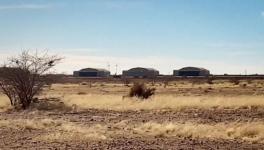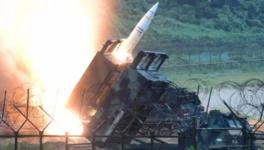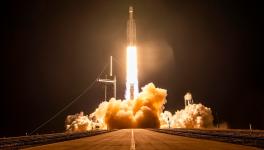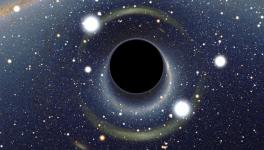New NASA Launch Vehicle: Rocket to Nowhere?
The first new US rocket or launch vehicle since the Space Shuttle, and indeed in terms of launch technology the first new rocket from any country in the past thirty years, was launched in a test flight from Cape Canaveral last week on October 31. The Ares I-X prototype is part of the next generation human space launch architecture designed to replace the ageing Space Shuttles that are due to retire next year. The new architecture, named Constellation and designed for travel beyond near-earth space, is slated to comprise two new rockets, the Ares-I to launch astronauts and a heavy-lift Ares-V to carry cargo and different payloads. The idea is that Ares-I would place the Orion crew capsule (successor to the aircraft-like Shuttle) in low-earth orbit, while the larger Ares-V would ferry the Altair landing craft to dock with Orion and fire rocket engines to take the crew capsule and lander on to the moon or even beyond, for instance to Mars.
The Ares I-X prototype lifted off from the Kennedy Space Centre in Florida on 28th October and spent just 2 minutes in powered flight and 6 minutes in all from lift-off till it had jettisoned the mock but accurate replica crew capsule and upper portions in space and the reusable booster engine had splashed down in the ocean about 200 kilometres away. The test launch had been postponed for a few days due to bad weather --- a continuing irony that shows the limitations even of ever-advancing space technologies --- but, despite a partial parachute failure resulting in the booster having a hard landing in the sea and getting quite badly dented, was eventually declared a success. Considering that the entire design exercise of the new rocket, the first new development in rocketry for several decades, was initiated just 3 years ago in 2006, one cannot fault that description. Yet, several questions loom over not just the new Ares I rocket itself or the supposedly next generation Constellation architecture, but over the entire programme of human space exploration by the USA and NASA. Even as the test launch was proceeding, a high-powered White House Committee was submitting its report on the future of US manned space flight and the technologies required for it. The Report raised many important issues including about whether or not the Ares I design should at all be pursued, prompting many to wonder whether this maiden test flight might not be its last. Since the US runs by far the world’s largest space programme, useful lessons would undoubtedly be learnt by other space-faring nations, including newcomers such as India which has announced and is now planning manned missions to the Moon, from this Report as well as how NASA views the development of the new technology.
The Ares Rockets:
Ares is the Greek god of war, a pseudonym for Mars, which NASA considered an appropriate name for the new rocket, symbolic of NASA’s future plans since the rocket was designed specifically for longer-duration space travel, for instance to the red planet. The numerical designations of “I” and “V” are tributes to past rockets that helped NASA blaze a trail in human space exploration, the Saturn I and Saturn V rockets that respectively took US astronauts first to low-earth orbits and then to the Moon. The Ares-I’s booster engine with solid fuel is directly derived from the Shuttle’s booster rocket. However, given the configuration of the Ares I, it was decided not to use the Space Shuttle Main Engine for the subsequent expendable liquid-fuel stages but a J2-X engine modified from the J2 engines that had powered the Apollo series Saturn rockets. The decision to build upon the basic Shuttle and Apollo technologies was deliberate and sought to economize on both production and launch facilities costs, while also reducing development time especially with regard to safety which is of paramount concern in designing human flight machines. The Ares’ solid booster engine has more payload-carrying power and acceleration than the Shuttle’s engine. Ares I can place more than 25 tonnes in low-earth orbit compared with the Shuttle’s ????, and is the most powerful rocket engine in use today. The main new feature of the liquid oxygen-hydrogen fuelled J2X engines is that, unlike the Shuttle’s engines which required to be started on the ground at launch itself, they are designed to be started in mid-air or near-vacuum, conditions that the crew capsule would encounter in low-earth orbits from where it needs to be powered onwards, say to the moon as in the Apollo series. The Ares I is thus a pencil-like vehicle with the liquid-fuel engines and upper stages sitting on top of the solid booster, while the Orion crew capsule, emergency escape mechanism and the launch abort system sitting atop in that order. It stands 327 feet tall, almost twice the height of the Shuttle but short of the Saturn V’s 363 feet. The description “skinny” is almost invariably used in write-ups about the Ares I. The launch abort system, sitting atop the crew capsule, is another important innovation. This system is specifically designed to try and save the crew in the eventuality of having to abort the launch at any one of three stages viz. on the pad or upto 25,000 feet, at mid-altitudes up to around 150,000 feet and during final ascent up to around 300,000 feet. The system is a fully and independently equipped pod with its own ejector and directional motors designed to instantaneously separate the crew capsule from the rocket below, take the capsule away from the rocket which is presumed to be burning or otherwise malfunctioning and then deploy parachutes to enable a soft landing. The most dangerous time for space crews is during launch when immense power and intense heat is being generated below them and, if anything goes wrong at that stage including even a shut-down of all systems causing the rocket to come crashing back to the land, the probability of the crew losing their lives has been put by NASA at 100 per cent. The abort system has been tasked to reduce these odds to reasonable but not great odds of 1 in 10! Incidentally, the legendary German rocket scientist Wehrner von Braun, designer of the V-1 and V-2 rockets that wreaked destruction on England during World War II and who led NASA’s design team that built the Saturn rockets, believed that solid booster rocket engines were simply too powerful and unsafe for human flight!
No future for Ares I?:
But even as Ares I was on the launch pad just days before lift-off, an authoritative and influential Report was released, raising questions about its future. The Augustine Committee, named after its Chairman Norman Augustine, retired aerospace engineer and chief executive at renowned military and aerospace major Lockheed Martin, had been set up under the previous Bush administration to go into the proposed return of the US to the Moon by 2020 and the Constellation programme tasked with this goal. For NASA of course, which had not built a new spacecraft in over thirty years and which some critics said had lost the necessary capabilities, the Ares I project has been of enormous significance. NASA saw the Ares I-X as a “pathfinder” vehicle, a chance for NASA to re-acquire design-development expertise and, in the words of a mission leader, “remind ourselves of what it takes to build a vehicle.” The Augustine panel, however, saw things differently. "With time and sufficient funds, NASA could develop, build and fly the Ares I successfully… the question is, should it?" The panel noted that NASA’s budget had been drastically and continually cut, even after the announcement of the “return to the moon” programme, and found a serious mismatch between goals and available funding. The Committee therefore found itself having to question the goals themselves, and also having to recommend several technology options that could operate within the funds available. Only one of the seven options underscored by the panel included Ares I. The Augustine panel felt that, while the craft itself was good, the cost, development time and its role within the Constellation programme were open to question. In essence, the Committee leaned to the view that, rather than using a leap-frog approach using Ares I till near-earth orbit and then going on to the Moon or Mars with the heavy lift Ares V, it would make more sense to use a single craft such as Ares V with a “lite” or cargo version being used for missions that ended at the Space Station or with placing payloads in earth orbits. The panel also favoured looking more closely at other vehicle designs including Shuttle variants. An expert opined that the favourable consideration of so many options itself spelt doom for Ares I. Some members of the panel and other experts closely involved with its work however felt this was not the end of the day for Ares I. One senior panelist, who had worked with von Braun on almost every rocket made in the Huntsville facility, felt that examining various alternatives was part of any mission and that Ares I may still be retained as the best choice. But the more important thing, he felt, was that “a mission has to be better defined, and then a rocket has to be built for that. You can't design a rocket for an open-ended mission of 'go to [the space] station' or 'return to the moon.'.
Goals and means of space exploration:
And therein lies the rub. What should be the goals of space exploration? And what means should best be adopted to achieve them? The Augustine Committee has raised many relevant issues, for the US of course but also for other nations to ponder over. The Report clearly felt that destination-specifics such as the Moon, Mars etc were putting the cart before the horse. “Planning for a human spaceflight program should begin with a choice about its goals, rather than a choice of possible destinations. Destinations should derive from goals, and alternative architectures may be weighed against those goals. There is now a strong consensus [in the United States] that the next step in human spaceflight is to travel beyond low-Earth orbit. This should carry important benefits to society, including driving technological innovation, developing commercial industries and important national capabilities, and contributing to our expertise in further exploration. Human exploration can contribute appropriately to the expansion of scientific knowledge… and it is in the interest of both science and human spaceflight that a credible and well-rationalized strategy of coordination between them be developed.” The Panel felt that the present US space programme was not geared towards these goals, was unsustainable in its present form and, with misplaced goals, did not have the budgets with which to achieve them. Most importantly perhaps, the Augustine Committee Report, noting that other nations too have space programmes cumulatively comparable to that of the US, states that while human spaceflight objectives should broadly align with key [US] national objectives, “significant accomplishments could follow [from] actively engaging international partners in a manner adapted to today’s multi-polar world [to] strengthen geopolitical relationships, leverage global financial and technical resources, and enhance the exploration enterprise.” After all, the Report emphasizes, the broader goal of space programmes and especially human spaceflight is the goal “to inspire the next generation of scientists and engineers, to shape human perceptions of our place in the universe…, [and ultimately] to chart a path for human expansion into the solar system.” A far cry indeed from chauvinistic goals and show-piece missions that characterized the US’ own space missions in the 60s and 70s, and is yet to be truly seen pervading the spirit of space programmes of most countries.
Get the latest reports & analysis with people's perspective on Protests, movements & deep analytical videos, discussions of the current affairs in your Telegram app. Subscribe to NewsClick's Telegram channel & get Real-Time updates on stories, as they get published on our website.























